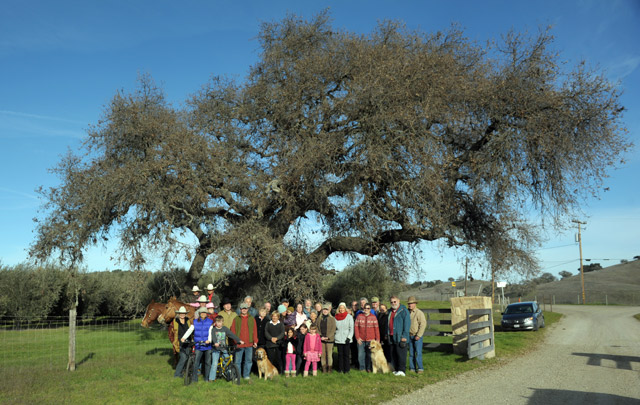Winery Ordinance Reality Check
Breaking Through the Hype as Supervisors Prepare to Vote on New Wine Country Rules

The folks who live and work in Santa Barbara wine country have been slogging through the county’s meticulous process of updating the winery ordinance for more than four years. Much is at stake for both winemakers and their neighbors alike.
The update was initiated, in short, because some residents — particularly those in Ballard Canyon — wanted stricter rules for future wineries when it came to road safety, traffic, noise, and other quality-of-life impacts. Winemakers, meanwhile, said that the rules were tough enough and already formed an impediment to any rampant growth, evidenced in the most grueling way by the now six-plus years that Michael Larner has been trying to get approval for his winery.
Since our cover story in January 2013, “A Tale of Two Valleys,” little has changed on the ground. But after four years of meetings, public comments, and environmental studies, the updated winery ordinance now exists on paper, having been approved by a 4-1 vote of the County Planning Commission in September. On November 1, the Board of Supervisors will decide whether to make this ordinance the law of the land.
Here’s a primer on what these new rules will mean for the industry and for the people who live nearby.
Why update the ordinance? “One of the goals was to address some of the ambiguities in the current ordinance that were leading to inefficiencies in the permitting of wineries,” said senior planner David Lackie. “It makes great strides toward adding additional clarity.”
How will it work? The new ordinance, like the old one, puts proposed wineries into three escalating tiers. Unlike the old one, the updated version is very specific in defining terms as well as prescribing minimum property sizes and how many acres of vines must be planted for the size of each winery. “The existing ordinance enabled someone to apply for the most intensive uses, but on relatively small acreage and relatively small planted vineyards,” explained Lackie.
So the new numbers are more restrictive than in the past, in terms of minimum lot sizes, mandatory acreages, allowed special events, and visitation rates. But it also lets all wineries have visitors during four “industry-wide” events per year, such as the Vintners’ Weekend. Higher tiers also allow for winemaker meals and cooking classes.
Do vintners like it? Not one bit. “The intent was to streamline the winery ordinance and make it clear what’s allowed and what’s not,” said Morgen McLaughlin, head of the Santa Barbara County Vintners’ Association. “It’s gone way beyond clarification and has become much more restrictive. It’s not even making it more black and white, but it is going to have a detrimental effect on the sustained and slow-growth development of the wine industry in Santa Barbara County.” She says wineries like Grassini and Hilliard Bruce would never have been approved under the proposed rules, and that it will raise the financial bar even higher for anyone wishing to enter the industry. “With the existing ordinance, it’s hard enough to make the numbers work for a profitable winery,” said McLaughlin. “The new ordinance makes it that much harder.”
She and many vintners want the Board of Supervisors to revert to the existing ordinance and to totally scrap the past five years of work.
What do neighbors think? They’re not pleased, either, especially those in Ballard Canyon, who claim their roads’ accident rates are higher than the state average. They hired Ana Citrin of Marc Chytilo’s law firm to request a special “roadway safety plan” provision that would require wineries located on dangerous roads to get special permission to host tastings and events. In an August 1 letter, Citrin wrote that their proposal had been “given no consideration” by staff, and she expressed dismay that the idea of a special planning “overlay” for Ballard Canyon has also been rejected.
Are the roads unsafe and busy? There’s a common-sense link between more places to sip alcohol and increased drunk driving rates — and lots of anecdotes repeated at hearings — but the statistics used by the county do not show any factual connection. “The [alcohol-related] collisions are occurring between 10 o’clock at night and 3 in the morning,” said Will Robertson from Public Works. “You can’t make the nexus that the wineries are causing collisions. I agree with that common sense [notion] … but there’s no link we can find.”
Nor are the roads especially busy, at least when using the statewide standards for capacity. “We don’t even touch the threshold of significance,” said Robertson.
How many wineries? There are 64 wineries on land controlled by the County of Santa Barbara, which started issuing permits in 1975. If you include wineries within city limits, there are 191 total. (By means of comparison, Napa County had 467 in 2015.)
There was a lot of growth in both vineyards and wineries from the mid-1990s through the early 2000s, according to Lackie, and there are a handful awaiting approval now, including The Hilt, Peake Ranch, and Larner. From 2000 to 2013, there was, on average, a little more than two wineries approved per year, so that’s the number planners used to project there could be 104 wineries by 2035.
But that growth is unlikely with or without stricter rules, said McLaughlin, explaining that the county and state are approaching somewhat of a saturation point. “You don’t see a flood of new projects,” she said.
Tasting rooms in Los Olivos? Vintners complain that the already strict rules have led to the oversaturation of tasting rooms in places like Los Olivos or even the Funk Zone in Santa Barbara, and that the new rules will compound that pressure. “What’s unusual about Santa Barbara County is that because of the existing land-use restrictions, it’s disincentivized the estate winery model and encouraged producers to open up stand-alone tasting rooms in urbanized areas,” said McLaughlin. “That’s become saturated in certain areas with diminished returns.”
“I won’t argue that’s entirely false,” said Lackie. “But a lot of those wineries that have tasting rooms in Los Olivos already have wineries in the rural areas.” The county may also propose new rules for tasting room permits for Los Olivos in the coming years.
Effect on winemakers new and old? The frequent claim that the new ordinance will hurt up-and-coming winemakers doesn’t ring true for the county planners. “It’s a rich man’s game no matter where you cut it,” said Lackie, noting that it can cost upward of $30,000 an acre to plant grapes. He doesn’t believe that the dreams of a young Allan Hancock College grad will be squashed by these rules. “It’s not a blue-collar-farming type of activity,” said Lackie. “It’s still gonna be an expensive endeavor at all levels.” He does note that the proposed rules would allow wineries to open a second tasting room on their property, which could possibly be used by an assistant winemaker for a side project.
Existing wineries will have their allowances grandfathered in, but if they want to expand or make major changes, they may be required to adhere to the new rules. McLaughlin says this will thwart innovation and may also affect the prices people will pay to buy existing wineries in Santa Barbara County. Altogether, she believes it will mean more grapes get shipped out of the county for processing. Lackie said the changes had to be “substantial” to trigger the new rules for an existing winery, but he added that what’s substantial can only be determined on a project-by-project basis.
How will supervisors vote? Both 3rd District Supervisor Doreen Farr, who led the charge for this update, and 2nd District Supervisor Janet Wolf are known as neighborhood advocates, so they will likely approve stricter rules. But the two North County supervisors, Peter Adam and Steve Lavagnino, tend to side with business and agricultural interests, both of which will be out in force on Tuesday. So they’re likely to vote against it.
Less predictable is Salud Carbajal, but it’s possible he may not even be at the hearing since he is running for Congress and Election Day will be a week away. As of press time, he does plan to attend. If not and a split vote occurs, the ordinance would be taken up by the new board some time next year.
4•1•1
The Santa Barbara County Board of Supervisors will consider the updated winery ordinance on Tuesday, November 1, at 9 a.m. in the Santa Maria hearing room. See tinyurl.com/sbwineord for the entire ordinance and planning history.



